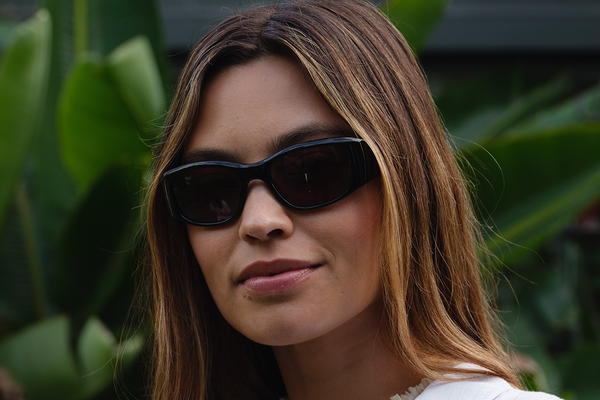Even a priceless frame can be ruined with bad fit. Like a fine tailored suit, the perfect fit leaves a lasting impression while something ill-fitting stands out like a neon sign. It doesn’t matter if it was hand stitched by Gianni Versace – if you put it on a giraffe, it looks bizarre. There’s a menagerie of shapes and styles in the GLCO world. You’re guaranteed to find a piece that is a worthy expression of your personal style and taste. This guide will demystify the science and subtle art of the perfect fit to ensure you step out looking like Gosling and not a giraffe. Frame fit has two factors: presentation and comfort. While comfort is pass/fail, style and overall fit have a much more flexible grade.


Frames meet you at two points: ears and bridge. For the ears, it’s worth noting that temple lengths are fairly universal and can be adjusted and tailored to your unique needs. A temple curve is heated and adjusted by hand by your optician to ensure a comfortable and secure fit. Too far back, they slip down the nose. Too early, and you feel discomfort at the top of the ear. When trying on frames, keep in mind that almost all frames can be molded to fit like a glove. Acetate frames have saddle bridges that are part of the frame shape. While this bridge style is immobile, some consider it more comfortable. Metals have adjustable nose pads that are almost infinitely customizable to suit any bridge shape. If you’re just dying for that Kinney or Hampton, fear not. There are alternative fit bridges available and custom nose pads can also be built for almost any acetate frame. Your dispensing optician will be your guide in looking amazing, but also feeling all day, effortless comfort.




Now comes the fun part: style. Looking for a flirty oversized? An articulate round metal? Style is all play, as long as you know what to look for. As much as we love smashing the status quo, there are some loose guidelines to nailing the perfect fit. It all comes down to a little geometry: Imagine you were to draw a line directly across the center, and another straight down the middle. Your eyes should sit in the upper hemisphere and the inner hemisphere closest to the nose respectively. The key here is balance.


Look at the negative space. If your eyes are crowded up and in and you have a lot of dead open space, consider something more tailored. If it’s oversized and big, make sure it’s big everywhere. The edges of the frame should fall just outside the cheekbones; it keeps things looking proportional and ensures the temples won’t squeeze the sides of the head, which exaggerates a small fit. If your eyes sit outside of center, the frame looks small even when it fits the overall face. If you have a severe prescription, round and tailored is a good rule of thumb. Ultimately, your optician will be your sherpa in determining what’s best for your unique needs.


At the end of the day, no one can tell you what you should and shouldn’t wear. If you love it and it feels great, wear it. There is no substitute for confidence. There’s a saying down here at the shop: “If you don’t love it, don’t bother.” Eyewear plays an intimate part in style and persona and, in this endeavor, half measures simply will not do.



